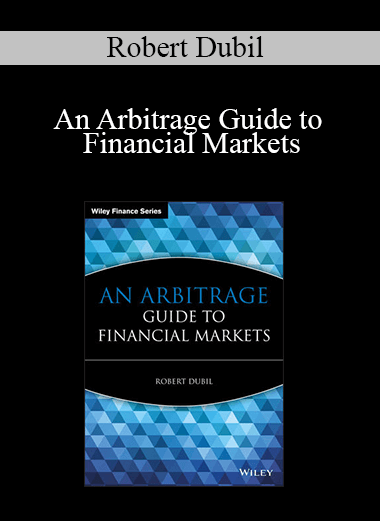An Arbitrage Guide to Financial Markets
The book is aimed at entrants into investment banking and dealing businesses, existing personnel in non-trading jobs, and people outside of the financial services industry trying to gain a view into what drives dealers in today’s highly integrated marketplace. A committed reader is guaranteed to leave with a deep understanding of all current issues.
“This is an excellent introduction to the financial markets by an author with a strong academic approach and practical insights from trading experience. At a time when the proliferation of financial instruments and the increased use of sophisticated mathematics in their analysis, makes an introduction to financial markets intimidating to most, this book is very useful. It provides an insight into the core concepts across markets and uses mathematics at an accessible level. It equips readers to understand the fundamentals of markets, valuation and trading. I would highly recommend it to anyone looking to understand the essentials of successfully trading, structuring or using the entire range of financial instruments available today.”
—Varun Gosain, Principal, Constellation Capital Management, New York
“Robert Dubil, drawing from his extensive prior trading experience, has made a significant contribution by writing an easy to understand book about the complex world of today’s financial markets, using basic mathematical concepts. The book is filled with insights and real life examples about how traders approach the market and is required reading for anyone with an interest in understanding markets or a career in trading.”
—George Handjinicolaou, Partner, Etolian Capital, New York
“This book provides an excellent guide to the current state of the financial markets. It combines academic rigour with the author’s practical experience of the financial sector, giving both students and practitioners an insight into the arbitrage pricing mechanism.”
—Zenji Nakamura, Managing Director, Europe Fixed Income Division, Nomura International plc, London
About the Author
Table of contents
1 The Purpose and Structure of Financial Markets 1
1.1 Overview 1
1.2 Risk sharing 2
1.3 The structure of financial markets 8
1.4 Arbitrage: Pure vs. relative value 12
1.5 Financial institutions: Asset transformers and broker-dealers 16
1.6 Primary and secondary markets 18
1.7 Market players: Hedgers vs. speculators 20
1.8 Preview of the book 22
Part One SPOT 25
2 Financial Math I—Spot 27
2.1 Interest-rate basics 28
Present value 28
Compounding 29
Day-count conventions 30
Rates vs. yields 31
2.2 Zero, coupon and amortizing rates 32
Zero-coupon rates 32
Coupon rates 33
Yield to maturity 35
Amortizing rates 38
Floating-rate bonds 39
2.3 The term structure of interest rates 40
Discounting coupon cash flows with zero rates 42
Constructing the zero curve by bootstrapping 44
2.4 Interest-rate risk 49
Duration 51
Portfolio duration 56
Convexity 57
Other risk measures 58
2.5 Equity markets math 58
A dividend discount model 60
Beware of P/E ratios 63
2.6 Currency markets 64
3 Fixed Income Securities 67
3.1 Money markets 67
U.S. Treasury bills 68
Federal agency discount notes 69
Short-term munis 69
Fed Funds (U.S.) and bank overnight refinancing (Europe) 70
Repos (RPs) 71
Eurodollars and Eurocurrencies 72
Negotiable CDs 74
Bankers’ acceptances (BAs) 74
Commercial paper (CP) 74
3.2 Capital markets: Bonds 79
U.S. government and agency bonds 83
Government bonds in Europe and Asia 86
Corporates 87
Munis 88
3.3 Interest-rate swaps 90
3.4 Mortgage securities 94
3.5 Asset-backed securities 96
4 Equities, Currencies, and Commodities 101
4.1 Equity markets 101
Secondary markets for individual equities in the U.S. 102
Secondary markets for individual equities in Europe and Asia 103
Depositary receipts and cross-listing 104
Stock market trading mechanics 105
Stock indexes 106
Exchange-traded funds (ETFs) 107
Custom baskets 107
The role of secondary equity markets in the economy 108
4.2 Currency markets 109
4.3 Commodity markets 111
5 Spot Relative Value Trades 113
5.1 Fixed-income strategies 113
Zero-coupon stripping and coupon replication 113
Duration-matched trades 116
Example: Bullet–barbell 116
Example: Twos vs. tens 117
Negative convexity in mortgages 118
Spread strategies in corporate bonds 121
Example: Corporate spread widening/narrowing trade 121
Example: Corporate yield curve trades 123
Example: Relative spread trade for high and low grades 124
5.2 Equity portfolio strategies 125
Example: A non-diversified portfolio and benchmarking 126
Example: Sector plays 128
5.3 Spot currency arbitrage 129
5.4 Commodity basis trades 131
Part Two FORWARDS 133
6 Financial Math II—Futures and Forwards 135
6.1 Commodity futures mechanics 138
6.2 Interest-rate futures and forwards 141
Overview 141
Eurocurrency deposits 142
Eurodollar futures 142
Certainty equivalence of EDfutures 146
Forward-rate agreements (FRAs) 147
Certainty equivalence of FRAs 149
6.3 Stock index futures 149
Locking in a forward price of the index 150
Fair value of futures 150
Fair value with dividends 152
Single stock futures 153
6.4 Currency forwards and futures 154
Fair value of currency forwards 155
Covered interest-rate parity 156
Currency futures 158
6.5 Convenience assets—backwardation and contango 159
6.6 Commodity futures 161
6.7 Spot–Forward arbitrage in interest rates 162
Synthetic LIBOR forwards 163
Synthetic zeros 164
Floating-rate bonds 165
Synthetic equivalence guaranteed by arbitrage 166
6.8 Constructing the zero curve from forwards 167
6.9 Recovering forwards from the yield curve 170
The valuation of a floating-rate bond 171
Including repo rates in computing forwards 171
6.10 Energy forwards and futures 173
7 Spot–Forward Arbitrage 175
7.1 Currency arbitrage 176
7.2 Stock index arbitrage and program trading 182
7.3 Bond futures arbitrage 187
7.4 Spot–Forward arbitrage in fixed-income markets 189
Zero–Forward trades 189
Coupon–Forward trades 191
7.5 Dynamic hedging with a Euro strip 193
7.6 Dynamic duration hedge 197
8 Swap Markets 199
8.1 Swap-driven finance 199
Fixed-for-fixed currency swap 200
Fixed-for-floating interest-rate swap 203
Off-market swaps 205
8.2 The anatomy of swaps as packages of forwards 207
Fixed-for-fixed currency swap 208
Fixed-for-floating interest-rate swap 209
Other swaps 210
Swap book running 210
8.3 The pricing and hedging of swaps 211
8.4 Swap spread risk 217
8.5 Structured finance 218
Inverse floater 219
Leveraged inverse floater 220
Capped floater 221
Callable 221
Range 222
Index principal swap 222
8.6 Equity swaps 223
8.7 Commodity and other swaps 224
8.8 Swap market statistics 225
Part Three OPTIONS 231
9 Financial Math III—Options 233
9.1 Call and put payoffs at expiry 235
9.2 Composite payoffs at expiry 236
Straddles and strangles 236
Spreads and combinations 237
Binary options 240
9.3 Option values prior to expiry 240
9.4 Options, forwards and risk-sharing 241
9.5 Currency options 242
9.6 Options on non-price variables 243
9.7 Binomial options pricing 244
One-step examples 244
A multi-step example 251
Black–Scholes 256
Dividends 257
9.8 Residual risk of options: Volatility 258
Implied volatility 260
Volatility smiles and skews 261
9.9 Interest-rate options, caps, and floors 264
Options on bond prices 265
Caps and floors 265
Relationship to FRAs and swaps 267
An application 268
9.10 Swaptions 269
Options to cancel 270
Relationship to forward swaps 270
9.11 Exotic options 272
Periodic caps 272
Constant maturity options (CMT or CMS) 273
Digitals and ranges 273
Quantos 274
10 Option Arbitrage 275
10.1 Cash-and-carry static arbitrage 275
Borrowing against the box 275
Index arbitrage with options 277
Warrant arbitrage 278
10.2 Running an option book: Volatility arbitrage 279
Hedging with options on the same underlying 279
Volatility skew 282
Options with different maturities 284
10.3 Portfolios of options on different underlyings 284
Index volatility vs. individual stocks 285
Interest-rate caps and floors 286
Caps and swaptions 287
Explicit correlation bets 288
10.4 Options spanning asset classes 289
Convertible bonds 289
Quantos and dual-currency bonds with fixed conversion rates 290
Dual-currency callable bonds 291
10.5 Option-adjusted spread (OAS) 291
10.6 Insurance 292
Long-dated commodity options 293
Options on energy prices 294
Options on economic variables 294
A final word 294
Appendix CREDIT RISK 295
11 Default Risk (Financial Math IV) and Credit Derivatives 297
11.1 A constant default probability model 298
11.2 A credit migration model 300
11.3 Alternative models 301
11.4 Credit exposure calculations for derivatives 302
11.5 Credit derivatives 305
Basics 306
Credit default swap 306
Total-rate-of-return swap 307
Credit-linked note 308
Credit spread options 308
11.6 Implicit credit arbitrage plays 310
Credit arbitrage with swaps 310
Callable bonds 310
11.7 Corporate bond trading 310
Index 313
Features
- All concepts are explained using detailed numerical examples of real finance transactions.
- Explains why most institutions rely on the interaction of dealers on large trading floors to take advantage of inter-market arbitrages.
- Written by a highly experienced practitioner.
Get download Robert Dubil – An Arbitrage Guide to Financial Markets at coursesblock.com right now!
Delivery Method
– After your purchase, you’ll see a View your orders link which goes to the Downloads page. Here, you can download all the files associated with your order.
– Downloads are available once your payment is confirmed, we’ll also send you a download notification email separate from any transaction notification emails you receive from coursesblock.com
– Since it is a digital copy, our suggestion is to download and save it to your hard drive. In case the link is broken for any reason, please contact us and we will resend the new download link.
– If you cannot find the download link, please don’t worry about that. We will update and notify you as soon as possible at 8:00 AM – 8:00 PM (UTC 8).
Thank You For Shopping With Us!







